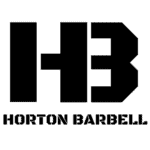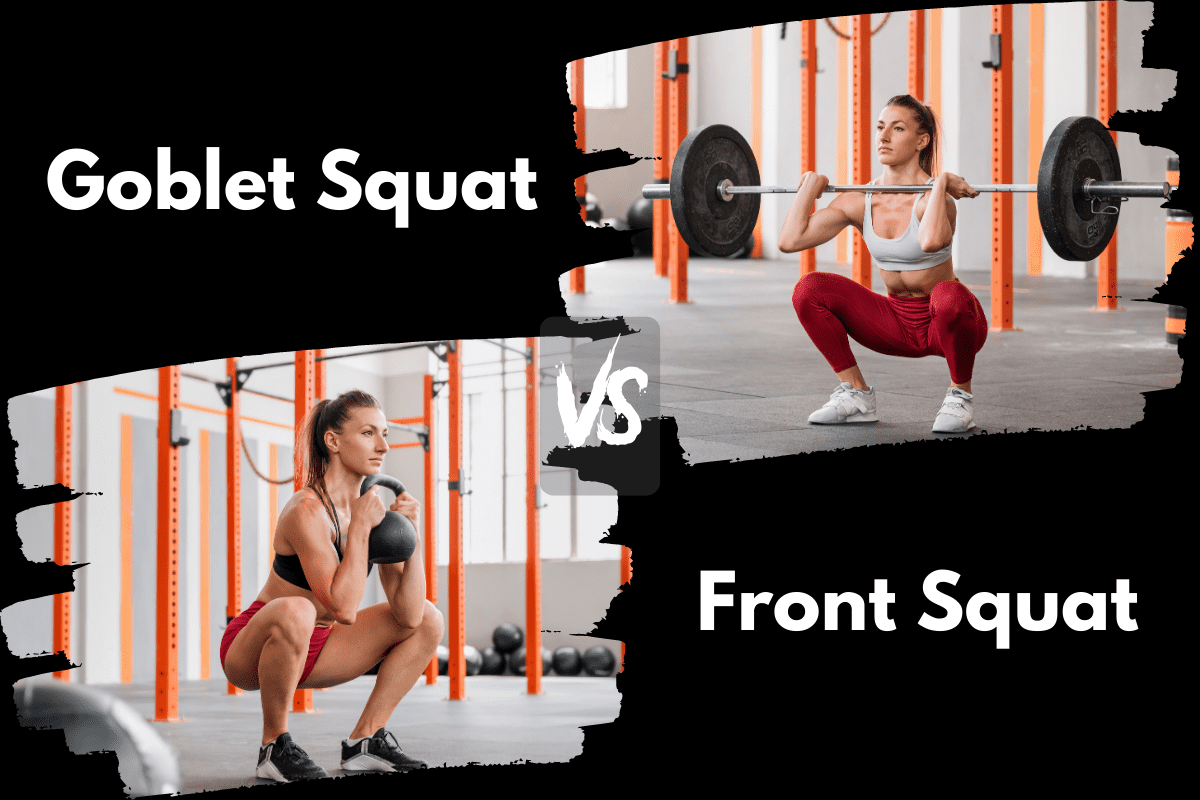Goblet Squat vs Front Squat (Is One Better For Strength?)
Goblet Squats and Front Squats are two popular, and very similar, squat variations. Both exercises involve anterior loading the body with resistance. With Goblet Squats it’s a kettlebell (or dumbbell) and for Front Squats it’s with a barbell.
The question is, is one of these exercises better than the other? In other words, which one should you be doing in your workouts?
The answer, as with many things, is it depends. It depends on what your goals are and what you’re trying to achieve.
In this article, I’m going to explain how each exercise is done and the benefits of each squat variation. I’ll also compare the two exercises side-by-side so you can get a better understanding of which squat is better for you based on your training goals and lifting preferences.
Goblet Squat
Equipment Needed
- Kettlebell (Dumbbell can be used as well)
Step-by-Step Instructions
- Grab a kettlebell and hold it at chest level, cradling the bottom of the bell in both hands*.
- Stand with feet shoulder-width apart, chest out, lats engaged, eyes straight ahead.
- Before descending into the squat, fill the abdomen full of air and brace the core.
- Start the start by pushing the hips back first.
- Bend the hips and knees, keeping the chest up and knees pushed out until the thighs become parallel to the floor.
- Now push the feet through the floor and drive yourself back up to the starting position.
- Repeat for the designated number of reps.
Coaching Points
*It’s also acceptable to hold the kettlebell on each side of the handle (as shown in the image above).
As with any squat, the most important aspect of the movement is to keep the core braced to protect the spine and to maintain proper posture – chest out and lats engaged.
Make sure to use full range of motion, even when doing Goblet Squats during high-tempo circuits.
Looking for Goblet Squat alternatives? Here are some of my favorite alternatives to Goblet Squats.
Benefits of Goblet Squats
Goblet Squats have several benefits, including:
Improved Core and Upper Body Strength
Holding a weight in front of the chest during a goblet squat requires the use of the core muscles to maintain proper posture and balance. Holding a weight in front of the chest also engages and works the upper back, shoulders and arms.
Improved Squat Technique
The Goblet Squat is a simpler squatting movement that allows people (especially younger lifters and/or beginners) to focus on proper form and technique, which can lead to better form and technique when performing more advanced squatting exercises.
Versatility
Goblet Squats can be performed with a variety of equipment, including dumbbells, kettlebells, and even sandbags, making them a versatile exercise that can be done at home or in the gym.
Beginner-Friendly
Goblet squats are a relatively easy exercise to learn and execute, which makes them a great option for beginners and young athletes with limited experience with weightlifting.

Tired of coming up with your own workouts? But don’t want to pay an arm and a leg?
I post workouts 5 days a week right here. (Did I mention they’re free?)
Front Squat

Equipment Needed
- Squat Rack
- Barbell
- Bumper or Iron Plates
- Lifting Straps (optional if needed)
Step-by-Step Instruction
- Set the height of the squat rack so that the barbell is about 1-2 inches below the flexed elbow (Elbow pointing toward the squat rack prior to taking the weight off the hooks).
- One of the first considerations you are going to want to make is what grip you want to use to perform the front squat.
- Later in the article, I will talk about different grips and the reasoning behind each grip.
- For now, I am going to assume you are using a two-finger clean grip. (Most commonly used by athletes).
- Walk closely to the barbell and place it very close to your neck.
- Bring your elbows up and the barbell should be resting on the raised anterior deltoid muscles. You are now holding the bar with what’s called a “front rack position” (THERE SHOULD BE NO STRESS OR TENSION ON THE HAND OR WRIST TO HOLD THE BARBELL).
- With your front rack, lift the bar off the hooks. I recommend a staggered stance to lift the barbell off the rack.
- Take 2 steps back and set your feet slightly wider than shoulder width. Toes slightly pointed out.
- Maintaining a strong front rack, take a deep breath, and brace the core.
- Initiate the squat by hinging the hips back and bending the knees simultaneously.
- Descend into the squat with control until your hip crease is slightly below the knee. (Most professionals consider this to be parallel or just below parallel).
- At this point, the core should be braced, the front rack strong, elbows up, and the lifter is ready to drive out of the “hole” and stand the weight back up.
- Keep a balanced foot with a strong arch, drive through the heels, and drive the hips until you are back at the top of the movement and ready for the next rep.
Grips
- Clean grip with 1 or 2 fingers. This is the most common grip used by Olympic lifters and athletes. This trains the specific position the bar would be in at the catch of a clean and therefore very advantageous for these athletes.
- Crossed arms. This is a common grip for athletes that want all the benefits from the front squat but may not have the flexibility or need for a finger grip.
- Lifting Straps. This allows the lifter to get the front rack position, engaging the upper back musculature, and takes a lot of stress off the fingers and wrists.
Coaching Points
By far the most common mistake with Front squatting (and most all compound movements) is improper form. Because the lift is very technical, uses the whole body, and requires patience and persistence, lifters oftentimes have incorrect form without realizing it, go up in weight too quickly, and may injure themselves.
Be patient with your flexibility. Persistence and working hard on your flexibility will pay off with front squatting. Remember to always warm up prior to any lifting session. Work on flexibility drills during warm-up sets as well. After your session, use cool-down techniques, foam roll, stretch, and hydrate.
In regards to your setup and form; treat every rep like it’s a 1 rep max. Put a tremendous amount of detail in your setup (Do it the exact same way, every rep). Make small gains in weight over time.
Benefits
Front Squats are a variation of the traditional back squat exercise. They have many of the same benefits, including building strength and power in the lower body and improving balance and coordination.
However, Front Squats have some additional benefits compared to back squats. Because the barbell is held in front of the body, front squats engage the core muscles more, helping to improve core stability and posture.
Front Squats can also help to improve mobility in the hips, ankles, and wrists.
Goblet Squat vs Front Squat: Which is Better?
Now, let’s take a side-by-side look at both squat variations to see if one is better than the other for a couple of common lifting goals.
Better For Size and Strength: Front Squat
The main reason Front Squat has a distinct advantage over Goblet Squat is the ability to scale the movement (continue to go up in weight).
At best, some of us may have access to a 2-pood (72-pound) kettlebell or maybe a 100-pound dumbbell if we’re really lucky. If you’re working out in a home gym it’s most likely to be even less.
So, Goblet Squats are going to have a hard logistical limit on how much strength you can build.
On the other hand, lack of equipment is rarely an issue with Front Squat for most lifters. If you have a barbell and a good set of plates you have more weight than most lifters will ever need. This allows you the ability to progressively overload the body and consistently improve strength and muscle mass.
Better For Beginners: Goblet Squat
Working with beginners and young athletes is where Goblet Squats really shine in my opinion.
The setup itself, holding a kettlebell versus placing a barbell on the shoulders is more beginner-friendly. You also have the ability to start with as light of a weight as needed.
This combo allows the lifter to really focus on learning and executing proper form – how to brace, proper torso position and correct movement patterns. Once a beginner becomes proficient with Goblet Squats it makes the transition to other squat variations much easier.

Get Shredded… For Free
Get a free workout Monday through Friday, posted right here on Horton Barbell. These workouts are designed to help you get strong, in shape and look great at the beach!
Final Thoughts
I’ve just spent the last section of this article comparing which is better – Front Squats vs Goblet Squats. I love Front Squat and believe it’s one of the most beneficial exercises an athlete (and non-athletes) can do.
Goblet Squats also have their place within a training program as well. They’re great for beginners to start to learn proper squat techniques and they can also be a great option to be included in circuit training.
The key is understanding what your goals are and then choosing the squat variation that helps get you there.
More Links and Info
Check out how Front Squats compare to other popular lower-body exercises:

